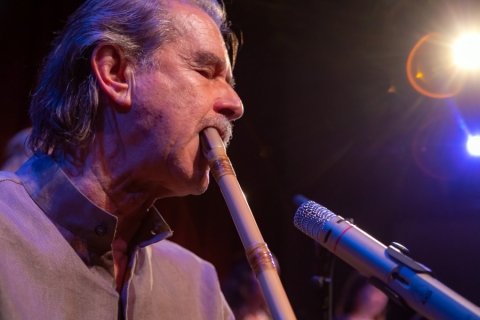Pioneering Persian Harmony
The Musical Legacy of Professor Hossein Omoumi
By Chiara Guastella
On Saturday, January 27, 2024, Maseeh Professor in Persian Performing Arts Persian Hossein Omoumi will perform at Winifred Smith Hall, opening the Music Faculty Artist Series for the year. We interviewed Professor Omoumi to learn more about him as an artist and educator.
Professor Hossein Omoumi teaches Persian music at UCI, but he commenced his music training with his father at the age of 14. He began singing and studying the Ney—the traditional reed flute of Iran—initially studying under great masters of Persian classical music such as Hassan Kassâei, Mahmud Karimi, and Farhâd Fakhreddini at the National Superior Conservatory of Music in Tehran. He has performed worldwide, including in San Francisco, UCLA, New York, and Paris.
Considered a noted scholar and teacher of Persian music, he has taught at universities such as UCLA, Sorbonne University in Paris, the National Conservatory, Tehran University, and the Center for Conservation and Diffusion of Music. Additionally, he graduated with honors in architecture from the National University of Iran and taught there for ten years after receiving his doctorate from the University of Florence, Italy.
As an architect and musician, he is familiar with visual and aural beauty. He has arranged and composed 11 lessons to teach the principles of Persian classical music under the title of Pish-Radif. His research on the making of the Ney and Iranian percussions has opened new possibilities and introduced significant innovations to the Ney, Tombak, and Daf, the last two being Persian percussive instruments.
Always knowing that teaching was his true passion and calling, Omoumi was encouraged to apply to teach Persian music at the Jordan Center for Persian Studies when it was established at UCI in 2006. He expressed his excitement about being selected for the role as the Maseeh Professor of Persian Performing Arts, explaining, “Classical cultures form the basis for creativity and innovation across all countries, including Persian classical music.”
For many, music is a way to communicate with the world. Omoumi’s message through music aspires to share the beauty of sounds, intervals, rhythms, and melodies of Persian classical music. He shared how the perception of music has changed in modern society.
“In modern societies, moments of silence are rare, and music can sometimes be overshadowed by noise. It is crucial to teach the younger generation to recognize and appreciate real, pure music amidst the cacophony of everyday life,” said Omoumi. He believes in using the power of art and music to move and connect people. His passion for Persian classical music is what he strives to convey to his students so that they are able to share it and communicate it with others.
Omoumi emphasized that he began learning music not through being taught but rather “with a music-loving father who encouraged his sons to play and sing.” He initially pursued a career in architecture, undertaking studies in both Iran and Italy. However, his perspective on music evolved over time. In addition to his nine years of academic pursuits, he spent a decade teaching at a university and engaged in architectural practice in both Iran and France.
When asked how his performance style has evolved throughout the years, Omoumi stated, “Evolution is natural, and my artistic life revolves around teaching students and fostering a love for music. My goal is to help the audience grow appreciation for music, and learn how to love music. Through this, I hope they develop a sense of unity.”
For this performance, Professor Omoumi is collaborating with UCSD professor Shahrokh Yadegari. Omoumi explained that Professor Yadegari has designed a computer music instrument called Lila that will accompany him with his own acoustic sounds.
“I will be responding to my own singing by playing Ney and vice versa in real-time,” said Omoumi. “I also will be accompanied by his electronics, which are composed based on Persian tunings and classical repertoire. This construct allows for a harmonious polyphonic expression of the inherently monophonic Persian classical music.”
Omoumi explained that Persian classical music is very improvisatory, and thus, his music and performance styles are rooted in improvisation based on pre-composed elements. “Details may change spontaneously during each performance depending on the moment.”
Professor Omoumi reflected on his career as a teacher and its biggest highlights. “During the first half of my life, I studied and taught architecture and music in Iran, and during the second half, I have been teaching music in Europe and the U.S. The most beautiful moments in my life are watching my students sing classical Persian poems from great Iranian poets of centuries ago by singing one of the 11 lessons called ‘Pish-Radif’ that I designed and composed to teach Persian classical music since many years ago. Also, Hearing the “tuned” sound of the traditional percussion instruments played by percussionists is a glorious feeling that I have.”
Professor Omoumi is a pioneer in introducing Persian classical music to the Western world, and we are thrilled to see what he will bring to the table during his performance on Saturday. The performance begins at 8 p.m. in the Winifred Smith Hall, and tickets are available through the CTSA Box Office.
Future Music Faculty Artist Series events:
Jan. 27, Music Faculty Artist Series: Hossein Omoumi: Innovations in Pedagogy and Instruments Design
Feb. 2, Music Faculty Artist Series: Yuliya Minina, piano
Feb. 9, Music Faculty Artist Series: Mari Kimura, violin
March 2, Music Faculty Artist Series: Lorna Griffitt, piano
Music Faculty Artist Series: Matt Hare, double bass
Music Faculty Artist Series: Dennis Kim, violin

